The technical side of "RadioAstrona"
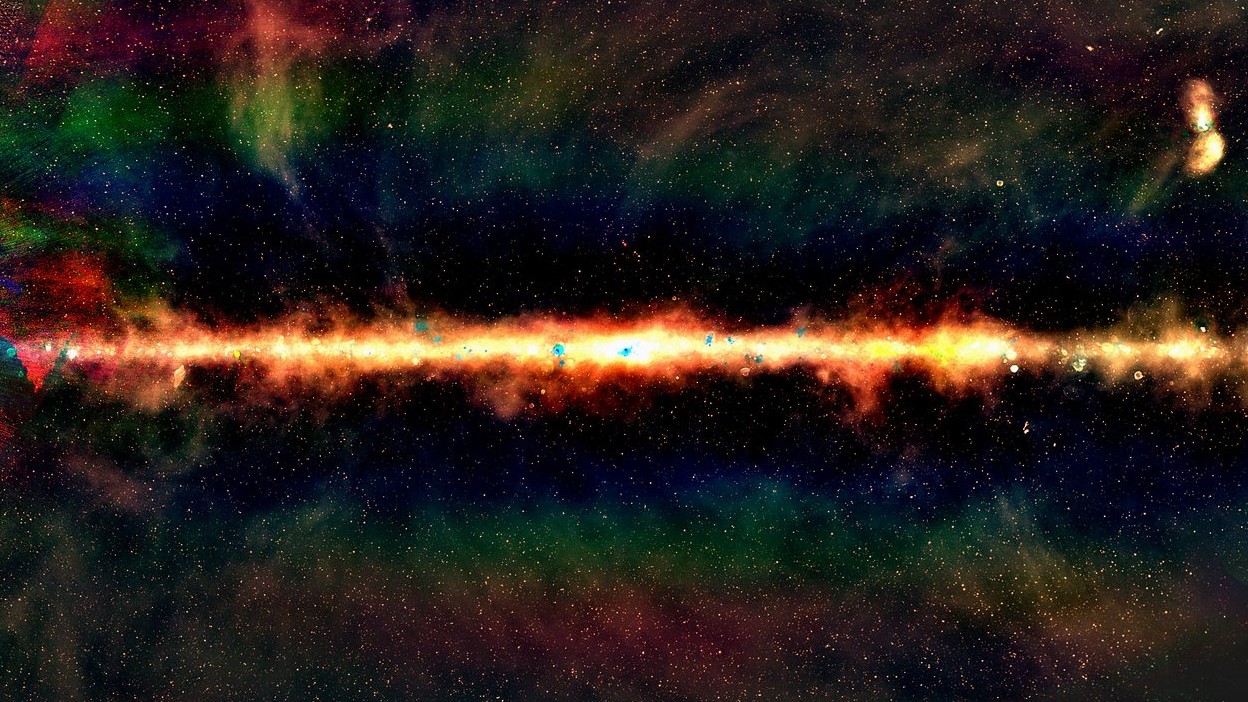
A photograph of the starry sky “GLEAM” taken in the 70-230 MHz radio wave band. In the center of the photo is the Milky Way , and on the sides - about 300 thousand other galaxies.
The space radio telescope RadioAstron currently has the largest angular resolution among all telescopes, and is also perhaps the most successful scientific project of the Russian non-manned cosmonautics.
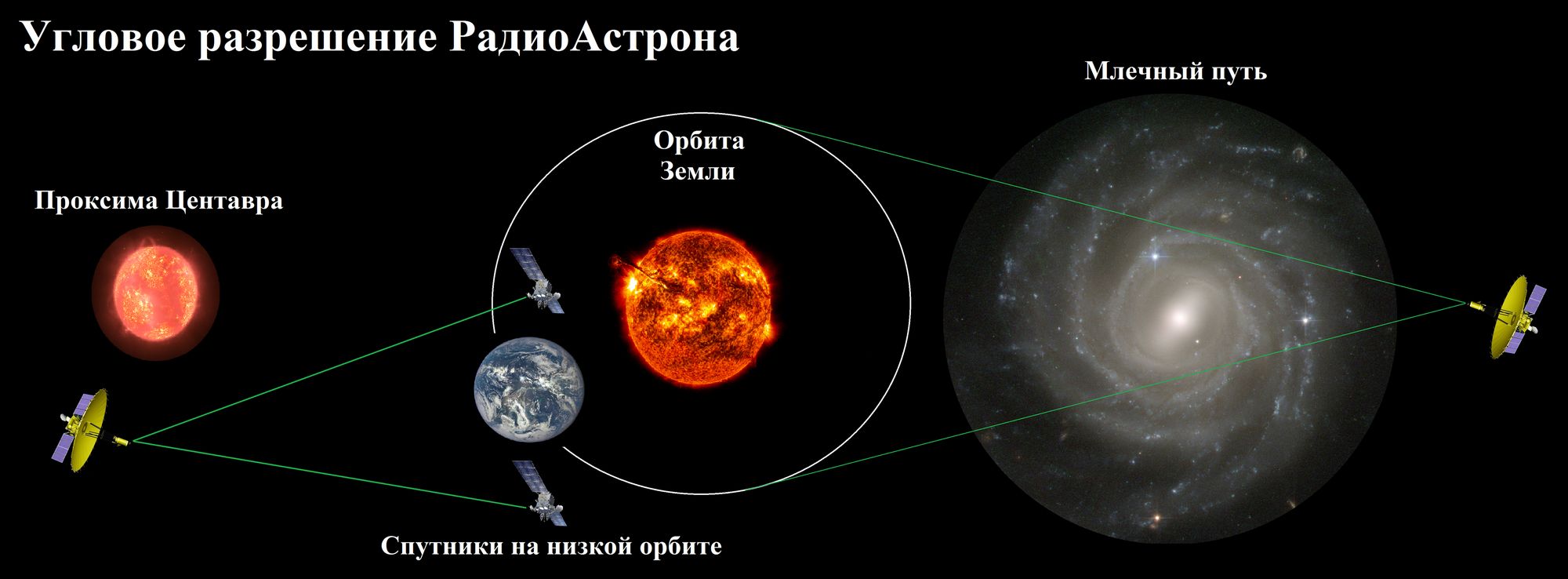
RadioAstron’s resolution is sufficient to distinguish between satellites on opposite sides of the DOE from Proxima Centauri or to distinguish between signals from two objects at the ends of the Earth’s orbit from the other end of our galaxy.
Today we will talk about the technical side of RadioAstron’s work with Alexander Plavin, research associate of the extragalactic radio astronomy laboratory of the FIAN Astro-cosmic Center and the laboratory of research of relativistic objects at MIPT.

Radio telescopes used to communicate with RadioAstronom.
How much does RadioAstron averagely produce scientific data per day? How large areas are used for its storage and processing?
In short, directly from the satellite - about 100 GB per day, from all telescopes working together - about 5 terabytes. For processing, 1 TFlop / s-cluster on the CPU is used, for storage - a combination of HDD and tapes, which occupies mostly one room.
In more detail: during direct observations from the satellite, there is a flow of scientific data of 128 Mbit / s + additional data and + margin. And this speed is steadily achieved for any satellite position in orbit - from 600 km to 340 thousand km. In this case, most of the time the telescope actually does not observe anything. There are three main reasons for this:
1) A radio interferometer is not one antenna, but several jointly simultaneously operating radio telescopes. Therefore, in addition to the Spectrum-R flying satellite, terrestrial antennas are needed, the larger (in size and number) the better. Accordingly, these telescopes must allocate their time to work together, and they, after all, have other observation programs. Moreover, it is necessary to choose the time when the observed object is visible both from the satellite (this is a lesser problem, of course) and from all the telescopes involved - and the Earth rotates.
2) Data reception from RadioAstrona is carried out only through one of two antennas on the Earth: in Pushchino (Moscow region) and in Green Bank (USA). Accordingly, the satellite should be visible from one of these stations over the entire observation period, and high enough above the horizon.
3) Receiving and transmitting equipment on board is not designed for many hours of continuous work - it overheats, both directly from its work, and from the Sun, if it falls on the device in the appropriate orientation. In most cases, this restricts observations not fundamentally, but it happens that some session needs to be shortened or canceled due to technical limitations of this kind.
Most of the data comes from ground-based radio telescopes working together. The fact is that the effective sensitivity of the entire jointly operating system (radio interferometer) increases with increasing sensitivity of individual telescopes; therefore, data from ground stations are recorded in the widest possible band and, accordingly, with a large flux. Typically, there are several Gbit / s from one telescope, of which up to a couple of dozen simultaneously work, the session time is up to several hours. All this data in different ways (dedicated Internet channels, sending HDD by mail, and even transporting HDD by employees going in the right direction) goes to the correlation processing departments: the main in ACIAN LPI in Moscow, also in Bonn (Germany).
Now the total amount of data is ≈5 petabytes, they are stored since the first experiments, and the removal is not planned. Despite the fact that only data directly processed on the correlator (which, in fact, selects the signal from the source, which is the same for all telescopes, from interferences, which are different everywhere) and have a smaller size, are used directly, the original raw data can be used and sometimes used for reprocessing, in case something has been improved / corrected in algorithms, or more precise information is obtained about the satellite orbit. Data is stored both on disks and tapes (archive), and occupy essentially one room. For processing, a CPU cluster with a total capacity of about 1 TFlop / s, ≈100 cores, is used. This is enough with a margin: for a typical observation, the correlation occurs several times faster than real time, which allows you to easily compare different parameters and their effect on the result.
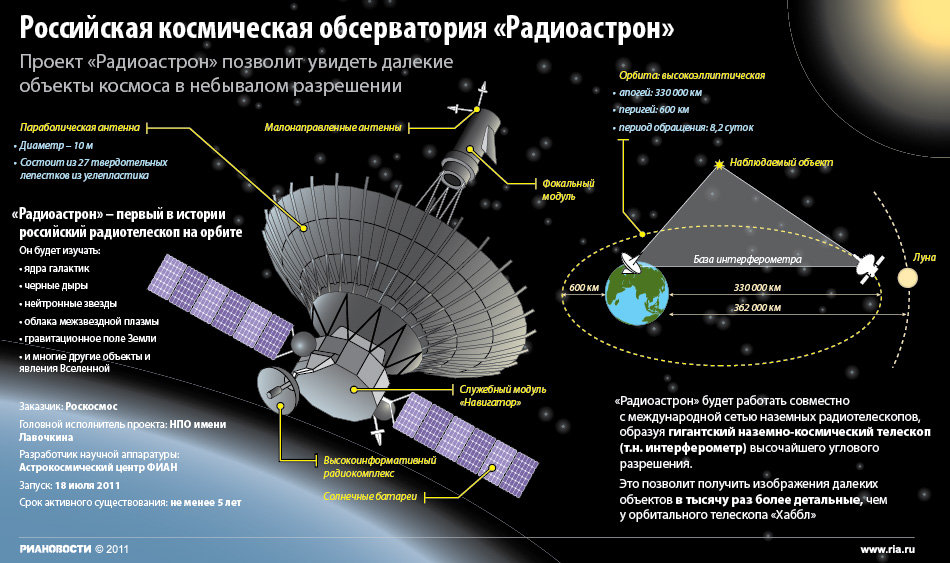
Device design
RadioAstron is in a highly elongated orbit: as far as I understand that, apart from the possibility of conducting observations in a wide range of conditions in this way, it still allows you to use plates located in Russia for communication most of the time?
In general, the elongation of the orbit and the use of Russian antennas are not particularly connected in any way - the Earth is rotating. Moreover, the data can be received with equal success by either of the two tracking stations, one each in Russia and the United States. Both were specially supplied with the appropriate equipment, both receiving and transmitting.
The elongation of the orbit gives various advantages:
- A pair of radio telescopes located in fixed locations gives a measurement of essentially only one point in the spatial frequency domain (Fourier transform of the observed image); taking into account the rotation of the Earth, one arc of an ellipse is obtained. The more such points / arcs are measured (and for as large a range as possible), the better for image reconstruction. Therefore, an elongated orbit allows one to measure spatial frequencies not only on one ellipse with the center in the Earth, as it would have been for a circular orbit, but at very different distances - from several thousand kilometers (the smaller distances are covered by pairs of telescopes located on Earth) to maximum 300 + thousand kilometers, albeit almost only in one direction. This opportunity is indeed often used - the same source is observed both with a large distance of the satellite, and when it approaches us.
- With the help of the satellite, other scientific problems that are not related to radio astronomy are solved. For example, it contains the most accurate hydrogen standards ever launched into space (atomic clocks), which allows for the highest accuracy to check for deviations from time dilation predicted by GTR (no discrepancies have been found yet). For this, it is important that the orbit is strongly elongated.
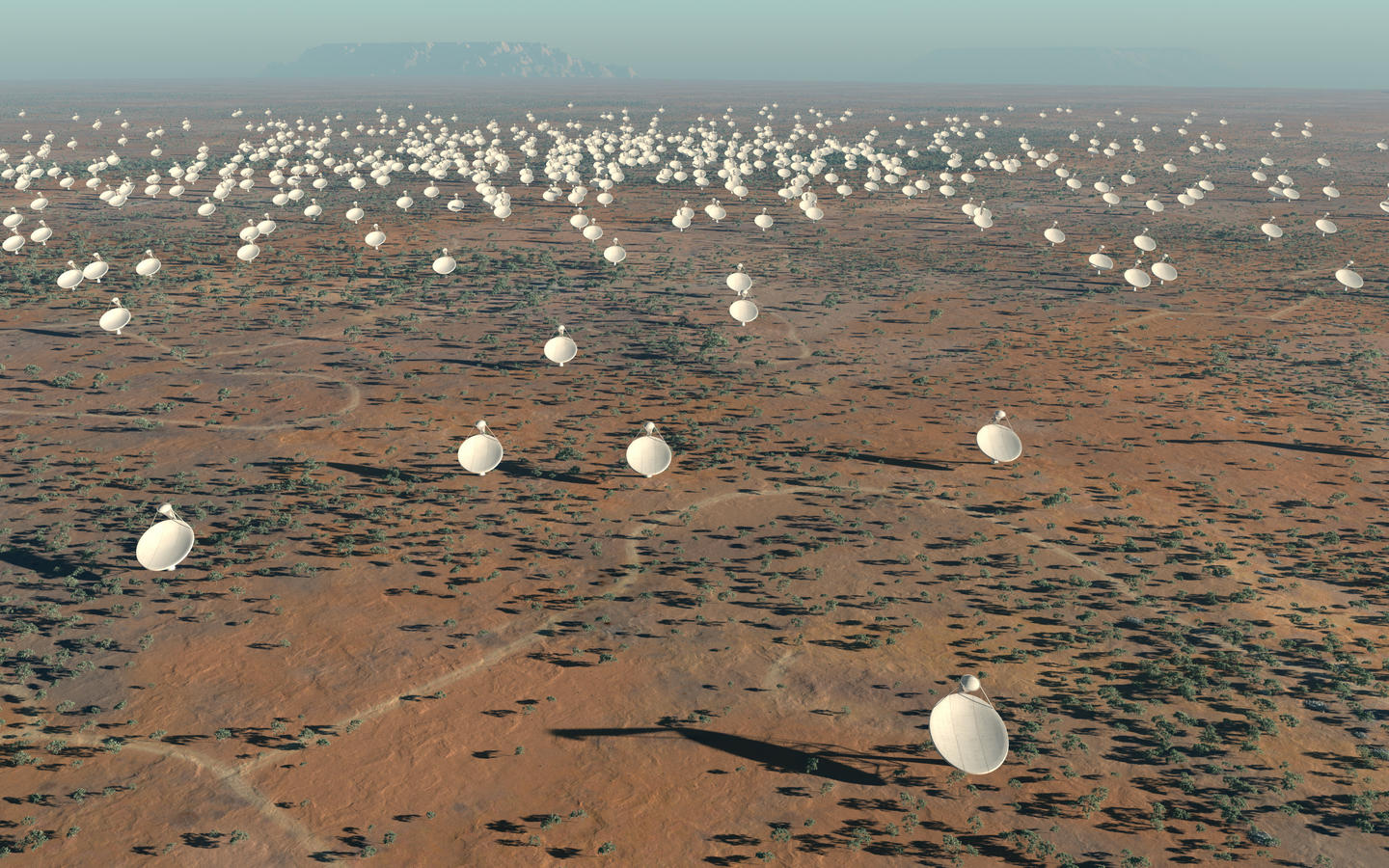
The most expensive ground-based telescope of modernity (price ≈ $ 2 billion) - SKA or "antenna array area of square kilometer." At the beginning of last year the first antenna sample was assembled of which it will be composed, and already this year its construction should begin.
For 3 out of 4 RadioAstron operation, one specific working frequency is indicated: is the radio telescope's speed constantly changing as it moves in orbit as a kind of “frequency modulator”?
The speed of the satellite is so small relative to the speed of light that it does not give any benefit to observations - the frequency changes to small fractions of a percent. Although, of course, it is the Doppler effect that is used for highly accurate measurement of the velocity of the apparatus - an error of the order of millimeters per second.

RadioAstron was born in this inconspicuous building. A detailed photo tour of the Pushchino radio astronomy observatory is available here .
How much of the total time is approximately able to load RadioAstron work?
In fact, right now, observations are carried out about 20% of the time, disregarding various technical procedures: unloading orientation flywheels, warming up and cooling receivers, transmitting commands and diagnosing the operation of all nodes, adjusting (adjusting orientation), etc.
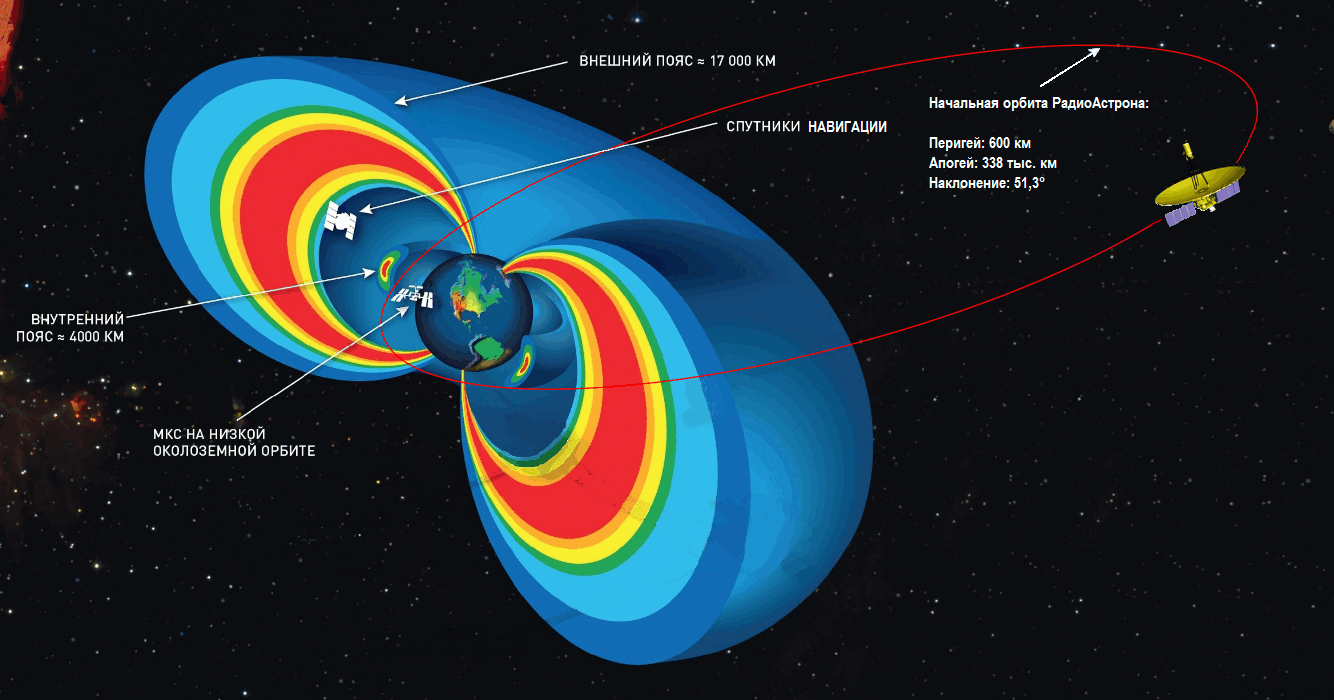
RadioAstron orbit and radiation belts
RadioAstron has to spend most of its time outside the magnetic field of the Earth and pass almost 100 times a year through radiation belts: is radiation accumulated by solar panels and electronics a deterrent to continue its work, or its lifespan is limited by the life of flywheels controlling its position / other factor ? Are there any estimates of how much more he can work?
By the way, it was precisely because of the passage through the radiation belt that it turned out to be useful to put on the satellite also various devices - charged particle sensors for regular research of such an environment of the Earth.
The operating time can be limited to any device - even with electronics, even with a flywheel. The various nodes are gradually failing, which is expected - the planned duration of work was 5 years, and RadioAstron has already flown 6.5. But at the current moment it is possible to conduct (and carry out) almost all types of observations, without significant losses. From the last - in the summer of 2017, hydrogen for the hydrogen standard (atomic clock) ran out on board; therefore, observations are now made in synchronization with the Earth. There is nothing bad in this - in fact, this method was originally planned for all observations in general. The hydrogen standard was more likely experimental equipment, but it turned out that it works without any problems and provides the required high constant motion. Accordingly, it was used for observations for 6 years; among other things, it is more convenient organizationally: for example, radiation from the Earth is not required and does not need to be coordinated.
There are also nodes that were originally reserved 2-3 times, and 1-2 of these copies failed. For example, flywheels that rotate and stabilize the apparatus — the currently achievable rotational speed is significantly lower than that which was possible at the beginning of work, but it is still within the calculated limits. Something has lost some of the functionality - for example, one of the polarizations in some ranges is not available for observations.
All of the above does not interfere with conducting observations and receiving applications for them - the main characteristics are normal. Especially no one undertakes to predict the rest of the time of work, because it is almost impossible to determine when any vital node that remains in a single copy fails.
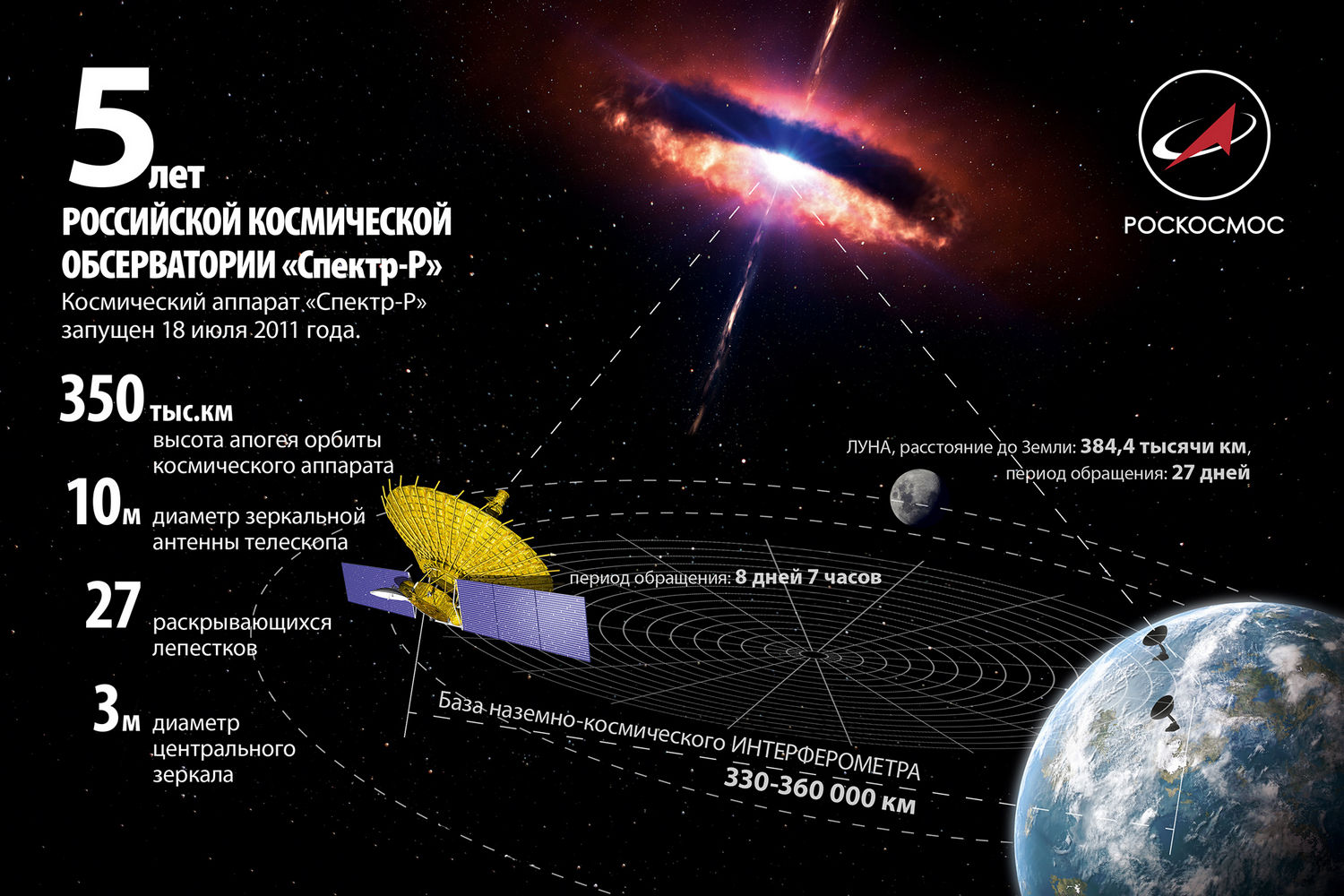
In mid-2016, RadioAstron completed its main 5-year mission and embarked on an expanded mission.
What do you think are the biggest scientific discoveries of RadioAstron at the moment?
I would single out such the most significant things:
- The discovery that the effect of radiation scattering in the interstellar medium is not only the expected "blurring" of the image, but small details, such as "ripples", also appear. On the one hand, this made it possible to see various objects such as pulsars with RadioAstron that would otherwise not be visible (the interferometer is fundamentally insensitive to a uniform extended / diffuse structure), and on the other hand, now this effect must be taken into account, for example, when running Event Horizon Telescope , who is trying to "see" the shadow of a black hole in the center of our galaxy. Actually, we are working closely with the EHT team on these issues.
- Detection of extremely high brightness in the centers of active galaxies. It used to be considered (not only from observations — there are rational physical theories that predicted this) that they are an order or two less bright, and accordingly this discovery significantly complemented our understanding of these objects, and some of the theories of the theories were refuted.
“For the first time, using high-resolution images, it was possible to study for the first time the internal structure of jets (outliers) from active galaxies, microwave laser in dust disks in our galaxy, and much more.
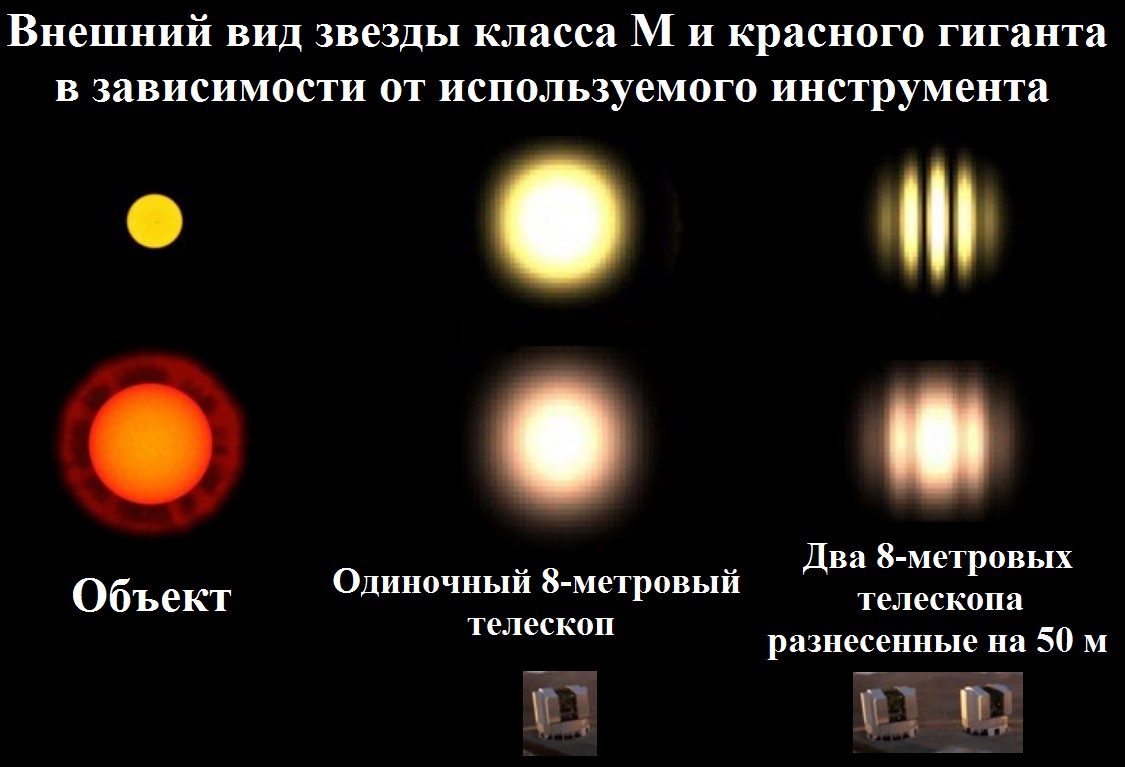
The advantages of using interferometry on the example of a pair of 8-meter telescopes of the VLT complex.
RadioAstron has several times higher resolution compared to terrestrial radio telescopes: was it possible in this way to detect some kind of dual or visual binary systems of radio sources?
At the same wavelength, the resolution is ten times more: compare 12 thousand km of the diameter of the Earth and 340 thousand km of the apogee of the orbit. As long as there are no specific detections of radioAstron dual systems, in fact, until recently no one was engaged in this task - there are not enough hands. There are expectations that it will be possible to find something on the basis of already available observational data.

Comparison of images in the visible and infrared spectrum of the Eagle Nebula : here you can clearly see how long the wavelength allows you to look further into the molecular cloud .
Now it is indicated that China is going to put into orbit two of its own devices similar to RadioAstron: are any plans being considered now to complete the work of our telescope to launch a new device with better characteristics or already into solar orbit?
The Chinese project is not "better" than RadioAstron, it is just a bit different: it targets more high-frequency bands, 8, 22 and 43 GHz. RadioAstron, for comparison, operates on 0.3, 1.6, 5, 22 GHz - that is, only one band is the same. At different frequencies emit different objects, and the properties of the interstellar medium are also different, so the scientific data of these projects will complement each other well.
It’s not so much to bring the radio interferometer into the solar orbit if it is observed together with terrestrial telescopes - besides the obvious problems of accurately determining its position, what I wrote above is very important - it’s very desirable to have the spatial coverage of the spatial frequency area as measured as possible. And if one antenna is at a distance of about 1 AU, and all other telescopes on Earth, then the benefits are much less.
The near-term outlook is the almost complete Spectrum-RG telescope (X-ray gamma), which is scheduled to be launched at the beginning of 2019. This is the only X-ray space telescope project in the world for the coming years, and it too (like RadioAstron, Spectr-R) will provide significant observational improvements in comparison with the available instruments.
Many thanks to Alexander Plavin for providing the interview. If you also want to thank him or ask him your questions, here is his nickname: chersanya
All Articles